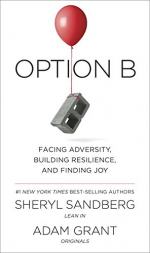|
This section contains 607 words (approx. 2 pages at 400 words per page) |

|
Option B: Facing Adversity, Building Resilience, and Finding Joy Summary & Study Guide Description
Option B: Facing Adversity, Building Resilience, and Finding Joy Summary & Study Guide includes comprehensive information and analysis to help you understand the book. This study guide contains the following sections:
This detailed literature summary also contains Topics for Discussion on Option B: Facing Adversity, Building Resilience, and Finding Joy by Sheryl Sandberg.
The following version of this book was used to create this study guide: Sandberg, Sheryl, and Adam Grant. Option B: Facing Adversity, Building Resilience, and Finding Joy. Alfred A Knopf, a division of Penguin Random House LLC, New York, NY, USA. 2017. First edition. The narrative is written in first-person, relatively short chapters, each of which uses both personal anecdote and commentary on relevant scientific research to explore the author’s discussion of various principles and aspects of developing resilience.
The author begins her considerations and commentary by sketching in the central relationship, and experiences within that relationship, that define the reason for the book’s existence – the beginning and end of her marriage. Both these experiences, she writes, were unexpected, the latter particularly so: her husband’s death, she says, was sudden, shocking, and traumatizing. The author then describes how her personal process of recovery was supported by the work and insights of psychologist Adam Grant, a friend and colleague whose work and research have formed part of the foundations for her own healing and the book’s analysis.
The author then begins a series of chapter-by-chapter considerations of different techniques for developing resilience, with each consideration anchored by personal experience, by stories of others who have had experiences related to the chapter’s particular subject, and by research undertaken by Adam Grant and other scientists.
There are several core components to these intertwined considerations. One is developing a sense of connection with, and respect for, self-recognition. This, the author contends, manifests in several ways: in acknowledgement of, and openness about, feelings, both positive and painful. This, she says can be difficult, particularly when painful, trauma-related feelings seem overwhelming, and when positive feelings, experienced in juxtaposition with negative ones, can seem inappropriate. Another value of self-recognition, the author contends, is in acknowledgement of basic elements of being human – the capacity for making mistakes, and for learning from them; the capacity for choosing silence instead of connection, and vice versa; and the value of choosing connection over distance. One last manifestation of self-recognition, the author suggests, comes in working to develop and sustain awareness of the capacity to grow, even in the face of challenging, traumatic experiences.
Another core component of the author’s considerations throughout the book is a sense of the value of community. This also manifests in several ways, the first being the author’s contention that connecting with people who have had similar traumatic experiences can provide strength, encouragement, and support. This is also true, she says, of people who might not have offered support because of having had similar experiences, but simply because of experiencing compassion, and wanting to help. This compassion, the author adds, can also be seen in the attitudes and actions of people who have come through trauma and feel motivated to help ensure that others do not suffer the same way they did. This, in turn, relates to one last way the author considers the value of community – specifically, her contention that there might be value in legally mandating some of the principles and practices that help individuals so that society in general can become more resilient.
Throughout the entire book, however, there is an underlying sense that while the development of resilience in individuals and communities is valuable and often necessary, the reasons that resilience BECOMES valuable and necessary never really go away – that is, experiences of trauma, both personal and communal. The author contends that developing resilience is necessary for day-to-day functioning in a world where there seems to be so much to struggle with in terms of socio-cultural circumstances, let alone individual, incident-based trauma.
Read more from the Study Guide
|
This section contains 607 words (approx. 2 pages at 400 words per page) |

|



